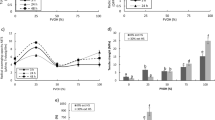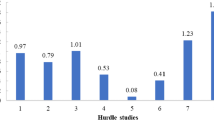Abstract
To evaluate the combined treatments of chestnut shell extract (CSE), fumaric acid (FA), and mild heat (MH) on the inactivation of Escherichia coli O157:H7 and Listeria monocytogenes inoculated on beetroot leaves, samples were treated with different concentrations of CSE or FA, as well as combinations of 0.5% CSE/0.5% FA and 0.5% CSE/MH at 50°C/0.5% FA. Among the treatments, the combined treatment of CSE/MH/FA was most effective, reducing the populations of E. coli O157:H7 and L. monocytogenes on beetroot leaves by 3.18 and 3.76 log CFU/g, respectively. In addition, the initial populations of pre-existing bacteria on beetroot leaves were reduced by 2.58 log CFU/g after the combined treatment. The inactivation effect was retained during storage at 4°C for 8 days. These results indicate that the combined treatment of CSE, FA, and MH can be effective in decontamination from foodborne pathogens and improving in the microbial safety of beetroot leaves during storage.
Similar content being viewed by others
References
Zieliska-Przyjemska M, Olejnik A, Dobrowolska-Zachwieja A, Grajek W. In vitro effects of beetroot juice and chips on oxidative metabolism and apoptosis in neutrophils from obese individuals. Phytother. Res. 23: 49–55 (2009)
Kim YJ, Lee SH, Park J, Park J, Chung M, Kwon K, Chung K, Won M, Song KB. Inactivation of Escherichia coli O157: H7, Salmonella typhimurium, and Listeria monocytogenes on stored iceberg lettuce by aqueous chlorine dioxide treatment. J. Food Sci. 73: 418–422 (2008)
Crowe KM, Bushway A, Davis-Dentici K. Impact of postharvest treatments, chlorine and ozone, coupled with low-temperature frozen storage on the antimicrobial quality of lowbush blueberries (Vaccinium angustifolium). LWTFood Sci. Technol. 47: 213–215 (2012)
Olmez H, Kretzschmar U. Potential alternative disinfection methods for organic fresh-cut industry for minimizing water consumption and environmental impact. LWT-Food Sci. Technol. 42: 686–693 (2009)
Barbosa IM, Medeiros JAC, Oliveira KAR, Gomes-Neto NJ, Tavares JF, Magnani M, Souza EL. Efficacy of the combined application of oregano and rosemary essential oils for the control of Escherichia coli, Listeria monocytogenes and Salmonella Enterica in leafy vegetables. Food Control 59: 468–477 (2016)
Ramos B, Miller FA, Brandao TRS, Teixeira P, Silva CLM. Fresh fruits and vegetables-An overview on applied methodologies to improve its quality and safety. Innov. Food Sci. Emerg. 20: 1–15 (2013)
Salaheen S, Nguyen C, Hewes D, Biswas D. Cheap extraction of antibacterial compounds of berry pomace and their mode of action against the pathogen Campylobacter jejuni. Food Control 46: 174–181 (2014)
Vázquez G, Fontenla E, Santos J, Freire MS, González-Álvarez J, Antorrena G. Antioxidant activity and phenolic content of chestnut (Castanea sativa) shell and eucalyptus (Eucalyptus globulus) bark extracts. Ind. Crop. Prod. 28: 279–285 (2008)
Barreira JC, Ferreira IC, Oliveira MBP, Pereira JA. Antioxidant activities of the extracts from chestnut flower, leaf, skins and fruit. Food Chem. 107: 1106–1113 (2008)
Lee NK, Jung BS, Na DS, Yu HH, Kim JS, Paik HD. The impact of antimicrobial effect of chestnut inner shell extracts against Campylobacter jejuni in chicken meat. LWT-Food Sci. Technol. 65: 746–750 (2016)
Hao JJ, Liu H, Donis-Gonzalez IR, Lu XH, Jones AD, Fulbright DW. Antimicrobial activity of chestnut extracts for potential use in managing soilborne plant pathogens. Plant Dis. 96: 354–360 (2012)
You TT, Zhou SK, Wen JL, Ma C, Xu F. Chemical composition, properties, and antimicrobial activity of the water-soluble pigments from Castanea mollissima shells. J. Agr. Food Chem. 62: 1936–1944 (2014)
Kim YJ, Kim MH, Song KB. Combined treatment of fumaric acid with aqueous chlorine dioxide or UV-C irradiation to inactivate Escherichia coli O157:H7, Salmonella enterica serovar Typhimurium, and Listeria monocytogenes inoculated on alfalfa and clover sprouts. LWT-Food Sci. Technol. 42: 1654–1658 (2009)
Kim JY, Kim HJ, Lim GO, Jang SA, Song KB. The ef fects of aqueous chlorine dioxide or fumaric acid treatment combined with UV-C on postharvest quality of ‘Maehyang’ strawberries. Postharvest Biol. Tec. 56: 254–256 (2010)
Kang JH, Song KB. Inactivation of pre-existing bacteria and foodborne pathogens on perilla leaves using a combined treatment with an organic acid and a surfactant. Hort. Environ. Biotechnol. 56: 195–199 (2015)
Forghani F, Oh DH. Hurdle enhancement of slightly acidic electrolyzed water antimicrobial efficacy on Chinese cabbage, lettuce, sesame leaf and spinach using ultrasonication and water wash. Food Microbiol. 36: 40–45 (2013)
Author information
Authors and Affiliations
Corresponding author
Rights and permissions
About this article
Cite this article
Park, SM., Kang, JH., Son, HJ. et al. Combined treatments of chestnut shell extract, fumaric acid, and mild heat to inactivate foodborne pathogens inoculated on beetroot (Beta vulgaris L.) leaves. Food Sci Biotechnol 25, 1217–1220 (2016). https://doi.org/10.1007/s10068-016-0193-5
Received:
Revised:
Accepted:
Published:
Issue Date:
DOI: https://doi.org/10.1007/s10068-016-0193-5




